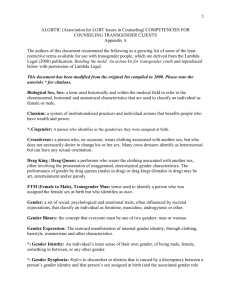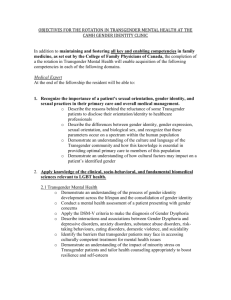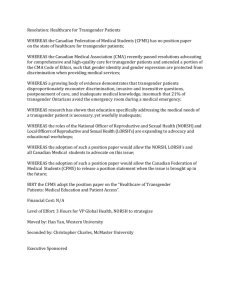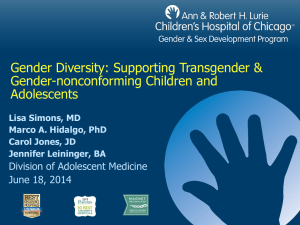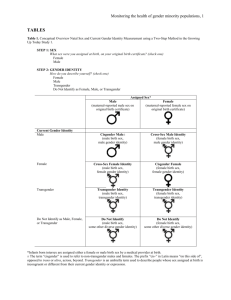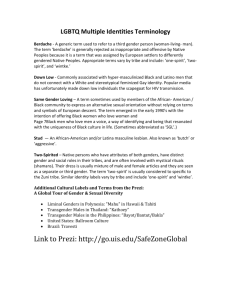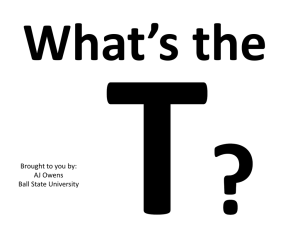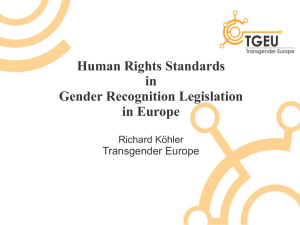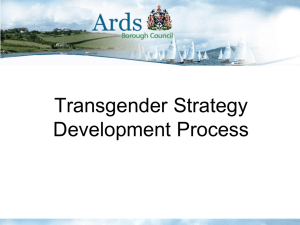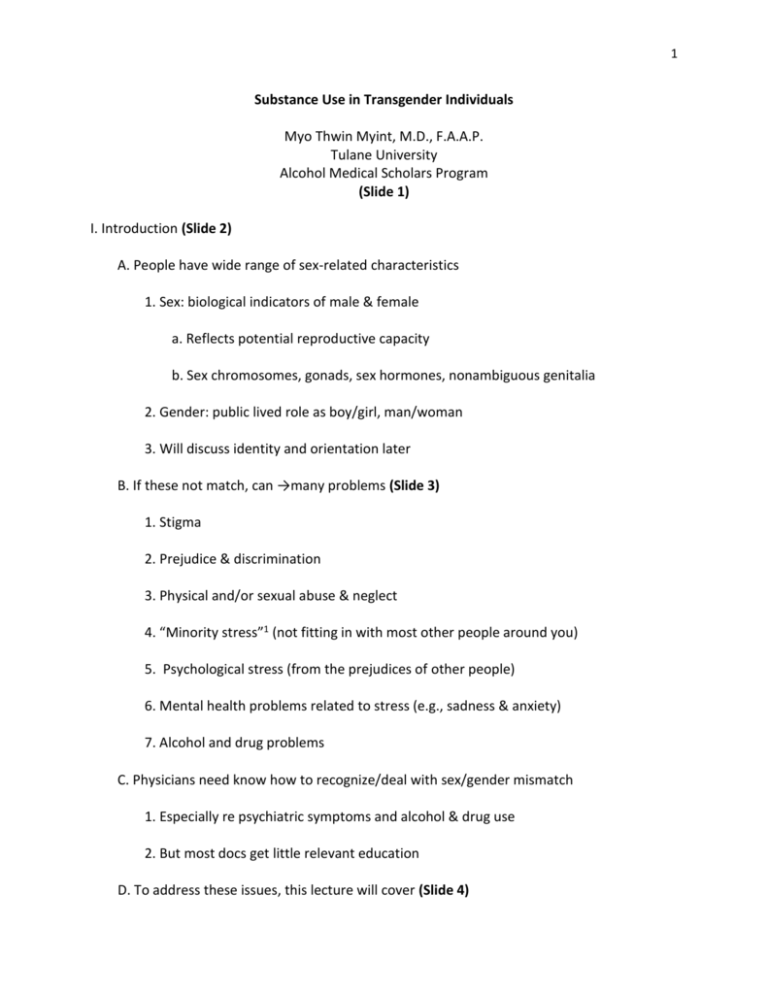
1
Substance Use in Transgender Individuals
Myo Thwin Myint, M.D., F.A.A.P.
Tulane University
Alcohol Medical Scholars Program
(Slide 1)
I. Introduction (Slide 2)
A. People have wide range of sex-related characteristics
1. Sex: biological indicators of male & female
a. Reflects potential reproductive capacity
b. Sex chromosomes, gonads, sex hormones, nonambiguous genitalia
2. Gender: public lived role as boy/girl, man/woman
3. Will discuss identity and orientation later
B. If these not match, can →many problems (Slide 3)
1. Stigma
2. Prejudice & discrimination
3. Physical and/or sexual abuse & neglect
4. “Minority stress”1 (not fitting in with most other people around you)
5. Psychological stress (from the prejudices of other people)
6. Mental health problems related to stress (e.g., sadness & anxiety)
7. Alcohol and drug problems
C. Physicians need know how to recognize/deal with sex/gender mismatch
1. Especially re psychiatric symptoms and alcohol & drug use
2. But most docs get little relevant education
D. To address these issues, this lecture will cover (Slide 4)
2
1. Definitions of terms related to sex & gender
2. Characteristics of transgender individuals
3. Psychiatric and substance use disorders in transgender individuals
4. Treatments for transgender individuals
II. Definitions of terms related to sex & gender (rapidly evolving terminology) (Slide 6)
A. Gender Identity: individual’s personal sense of self as male, female, or alternative2
B. Transgender: identify with a gender different from their natal sex3 (Slide 7)
1. E.g., natal male who has girl/woman gender identity
2. E.g., natal female who has boy/man gender identity
C. Transsexual3
1. Seek/undergo social transition to different gender
2. Many had somatic transition by hormone & surgical Rx
D. Transvestism: cross-dressing behavior more typical of the other sex in a given culture3
E. Sexual orientation: sex of the person to whom one is erotically attracted2 (Slide 8)
1. Androphilia: sexual attraction to men/masculinity4
2. Gynephilia: sexual attraction to women/feminity4
III. Characteristics of transgender individuals (Slide 9)
A. Criteria in 5th edition of Diagnostic & Statistical Manual (DSM-5) for Gender Dysphoria4
(Slide 10)
1. Children: 6+ of the following lasting 6+ months
a. Strong desire/ insistence re being other gender
b. Cross-dressing (because feel is more appropriate for self)
3
c. Preference in cross-gender roles in play (e.g., natal male plays as princess)
d. Preference in toys/games/activities of other gender
e. Preference for playmates of other gender
f. Rejection of typical natal gender toys/games/activities
g. Dislike of one’s sexual anatomy
h. Desire for sex characteristics of experienced gender
I. The 6+ items must → distress and/or impairment
2. Adolescents & adults: 6+ months of 2+ of (Slide 11)
a. Incongruence between experienced gender and sex characteristics
1’. E.g., natal female not like having breasts
2’. E.g., natal male not like having penis
b. Desire to be rid of one’s sex characteristics
c. Desire for sex characteristics of other gender
d. Desire to be other gender
e. Desire to be treated as other gender
f. Conviction of having feelings/reactions of other gender
g. The 2+ items must → distress and/or impairment
B. Gender noncomformity not = gender dysphoria (Slide 12)
1. Gender conformity = behaviors/appearance as society expects
a. Male who dresses/acts what society calls masculine
b. Female who dresses/acts what society calls feminine
2. Gender nonconformity = dressing/acting that society views as gender atypical
4
3. Does not indicate sexual orientation (Slide 13)
4. Can apply to people who
a. Have no impairment
b. Have no distressed
5. Definition varies with time & place5
a. In 1900 could relate to ♀ who wears pants
b. Are societies where ♂ kiss/hold hands acceptable and others where not
6. Gender dysphoria, however, apply (Slide 14)
a. Only to some transgender individuals6
b. At times experiencing clinically significant distress
c. Related to gender incongruence
7. Being transsexual, transgender, gender nonconformity = diversity, not pathology
(Slide 15)
B. Prevalence (likely underestimate)7 (Slide 16)
A. 0.01% of male sex at birth (natal male)
B. 0.003% of natal female
C. Development & course of transgender individuals (Slide 17)
1. Cross-gender behaviors begins 2-4yo4
2. Gender dysphoria persists from childhood to adolescence/adulthood in
a. ~ 30%4 of natal males (attraction: androphilic)
b. ~ 50%4 of natal females (attraction: gynephillic)
c. Intensity of early gender dysphoria predicts persistent dysphoria
5
d. If seen in adolescents, likely to persists8
3. In those gender dysphoria does not persist (desisters)4 (Slide 18)
a. Natal males have androphilic attraction /self-identify as gay/homosexual
b. Natal females have gynephilic attraction / self-identify as lesbian (only ~ 50%)
4. Some have onset of gender dysphoria @ puberty or later with (Slide 19)
a. Natal males
1’. Transvestic behavior in youth
2’. Gynephilic attraction including to post transition natal males
3’. Self identify as lesbian post gender transition
b. Natal females (rare to have late-onset)
1’. No transvestic behavior in youth
2’. Androphilic attraction
3’. Self identify as gay post gender transition
5. Picture break (Jazz, natal male with persistent gender dysphoria) (Slide 20)
D. Summary of differential diagnosis of gender dysphoria (Slide 21)
1. Rule Out (R/O) noncomformity to gender roles
a. Tomboyism in girls
b. Girly-boy behaviors in boy
c. Occasional non-typical gender behavior/appearance in adults
2. R/O transvestic Disorder (D/O)
a. Heterosexual or bisexual adolescent and adult males
b. Cross dressing generates sexual excitement
6
c. Causes distress/impairment (different than behavior alone)
d. Primary gender person perceives for self is clear
3. R/O body dysmorphic D/O (Slide 22)
a. Body part is perceived as abnormally formed
b. Focuses on the alteration or removal
4. R/O Schizophrenic and other psychotic D/O
a. Hallucination (i.e. hearing voices) or paranoia
b. Rare only to have delusion of other gender in schizophrenia
c. Usually presents with other psychotic symptoms
IV. Higher rater of sychiatric & substance use disorders in transgender groups (limited studies)
(Slide 23)
A. Prevalence of any Diagnosis 70% lifetime & 40% current9 (Slide 24)
B. With those with Major Depressive Disorder (MDD) (Slide 25)
1. ~ 60% of transgender have suicidal thought vs. ~40% in general population 4
2. ~ 30% of transgender have attempted suicide13 vs. ~10% in general population4
B. Social anxiety D/O10 (Slide 26)
1. Brief definition: marked, persistent, and out of proportion fear of social situations4
2. 45% versus 7% general population4 (Slide 27)
3. Perhaps relates to
a. Fear of criticism of transsexual appearance
b. Overall stress of being transsexual
C. Major depressive episode12 (Slide 28)
7
1. Brief definition: 2+ wks ↓joy, poor sleep, ↓ appetite, suicidal
2. 26% versus 7% general population4 (Slide 29)
5. Perhaps related to
a. Recurrent dealing with prejudice & discrimination
b. Barrier to Rx (mistrust) → worsening depression → suicide
D. Posttraumatic stress disorder11 (Slide 30)
1. Brief definition: intrusive sx (flashback), avoidance, neg mood, hyperarousal
2. 13% versus 9% general population4 (Slide 31)
3. Perhaps related to
a. More likely to be abused physically and sexually
b. Likely experience repeated trauma
E. Substance use & disorders in transgender population
1. Stimulant use
a. Cocaine 40%10 vs. ~ 15% general population (Slide 32)
b. Methamphetamine: >40%15 vs. ~ 5% general population (Slide 33)
2. IV drug use: ~40%15 vs. ~25% general population (Slide 34)
3. Tobacco use ~ 70% vs. ~20% general population (Slide 35)
V. Treatments for those with gender dysphoria (Slide 36)
A. Clinicians need to make patients feel comfortable16 (Slide 37)
1. Use the proper pronouns based on their self-identified gender
2. Help patients understand the Rx options with risks and benefits
B. Possible physical Rx of gender dysphoria (Slide 38)
8
1. Hormones are initial physical Rx
a. Estrogen is used for male-to-female transition
b. Testosterone is used for female-to-male transition
c. Suppressors (“blockers”) of gonadal steroids are used to block puberty
1’.E.g., GnRH analog, spironolactone
2’. Rationale: difficult to reverse the physical changes w/ puberty
3’. Provide options for adolescents while making decisions about Rx
d. High rate of using hormones without proper physician’s supervision
e. Side effects may include symptoms of (Slide 39)
1’. Hypomania /mania (e.g., ↑mood, need for sleep, pressured speech)
2.’ Psychosis (e.g., hearing voices that aren’t there, paranoid)
f. Physician needs to be mindful of interactions with substance use such as
1’. Smoking + estrogen → risk of blood clot15
2’. Smoking + testosterone → risk of heart disease15
g. Frequency of psychiatric diagnoses if receiving hormone therapy vs. not 14
2. Surgery is irreversible Rx (Slide 40)
a. Some may not desire or need surgery while others do
b. Only 1-2% of transgender patients regret of having the surgery17
c. Has shown improvement gender dysphoria sx & psychological fxn18
C. Psychosocial Rx of gender dysphoria
1. “Reparative therapy” to force natal gender is unhelpful & potentially harmful19
(Slide 41)
9
2. Psychotherapy helpful to (Slide 42)
a. Explore gender identity, role, and expression (how one shows his /her gender)
b. Address negative impact of gender dysphoria & stigma on mental health
c. Alleviate internalized hatred toward self for being transgender (transphobia)
d. Enhance social & peer support
e. Improve body image by matching expectations and reasonable outcomes of Rx
f. Promote resilience by learning strategies to tackle stigma, discrimination, etc.
3. Voice & communication therapy are used to facilitate comfort w/ gender identity
(Slide 43)
a. Male-to-females learn to speak in higher pitch
b. Female-to-males learn to speak in deeper tone
4. Hair removal particularly for male-to-females
5. Prior to surgery: learn to dress to appear as self identified gender
a. Male-to-females may learn about genital tucking, breast padding
b. Female-to-males may learn about penile prostheses placing, breast binding
D. Transgender population face additional barriers such as (Slide 44)
1. Discrimination
2. Provider hostility & insensitivity
3. Strict binary gender segregation in programs
4. Lack of acceptance in recovery groups
E. Overall Rx require of collaborative care with different specialties: (Slide 45)
1. Primary care physicians (pediatrician -> internist or Family Med) coordinate care
10
2. Mental health providers are important to assess (Slide 46)
a. Comorbid diagnoses including substance use
b. Psychiatric sx caused by physical Rx such as hormones
3. Other specialists are essential because of the specialized needs including (Slide 47)
a. Endocrinologists for hormonal Rx
b. Urologists for genital surgeries
c. Gynecologists for pre & post operative care
d. Plastic surgeons for facial & breast surgeries
e. Non-traditional care (eg. (pic)Thomas Beatie, transgender ♂, who got pregnant)
F. Rx outcomes are impressive20 (Slide 48)
1. 80% will no longer have gender dysphoria
2. >75% ↓ ↓anxiety, depression
3. 80% have ↑quality of life
VIII. Conclusion (Slide 49)
A. Terms related to sex and gender are changing and physicians need to be familiar
B. Being transgender is not pathologic but require interventions to eliminate dysphoria
C. Transgender have higher rate of psychiatric disorders including substance use disorders
D. Must be mindful of Rx barriers & requirement of collaborations with many providers
IX. Resources (Slide 50)
X. Graphic during questions (Slide 51)
11
References
1. Meyer IH. “Prejudice as stresses: conceptual and measurement problems.” Am J Public
Health. 2003 Feb; 93(2):262-5.
2. Adelson SL, American Academy of Child and Adolescent Psychiatry (AACAP) Committee on
Quality Issues (CQI). “Practice Parameter on Gay, Lesbian, or Bisexual Sexual Orientation,
Gender Nonconformity, and Gender Discordance in Children and Adolescents.” J Am Acad
Child Adolesc Psychiatry. 2012 Sep; 51(9): 957-74.
3. World Professional Association for Transgender Health. Standards of Care for the Health of
Transexual, Transgender, and Gender-Nonconforming People. 7th Edition. 2012.
4. American Psychiatric Association. Diagnostic and Statistical Manual of Mental Disorders, 5th
Edition. Arlington, VA, American Psychiatric Association, 2013.
5. Grollman, EA. “What is Gender ‘Non-Conformity’?” Kinsey Confidential.
http://kinseyconfidential.org/gender-nonconformity. 2011 Mar.
6. DeCuypere G, Knudson G, Bockting W. “Response of the World Professional Association for
Transgender Health to the Proposed DSM 5 Criteria for Gender Incongruence.” 2010 May.
7. Van Kesteren PJ, Gooren LJ, Megens JA. “An Epidemiological and Demographic Study of
Transexuals in the Netherlands.” Arch Sex Behav. 1996 Dec; 25(6): 589-600.
8. Spack NP, Edwards-Leeper L, Feldman HA, et al. “Children and Adolescents with Gender
Identity Disorder Referred to a Pediatric Medical Center.” Pediatrics. 2012 Mar; 129(3):
418-25.
9. Hepp U, Kraemer B, Schnyder U, et al. “Psychiatric Comorbidity in Gender Identity Disorder.”
J Psychosom Res. 2005 Mar; 58(3): 259-61.
12
10. Williams C, Jones, S. “Intro to Transgender Issues: Substance Abuse” Texas Association of
Drug Court Professionals Conference. 2013 Feb.
11. Roberts AL, Rosario M, Corliss HL, et al. “Childhood Gender Nonconformity: a Risk Indicator
for Childhood Abuse and Posttraumatic Stress in Youth.”Pediatrics. 2012 Mar; 129(3): 4107.
12. Roberts AL, Rosario M, Slopen N, et al. “Childhood Gender Nonconformity, Bullying
Victimization, and Depressive Symptoms across Adolescence and Early Adulthood: an 11year Longitudinal Study.” J Am Acad Child Adolesc Psychiatry. 2013 Feb; 52(2): 143-52.
13. Clements-Nolle K, Marx R, Katz M. “Attempted Suicide among Transgender Persons: the
Influence of Gender-based Discrimination and Victimization.” J Homosex. 2006; 51(3): 5369.
14. Smith YL, van Goozen SH, Cohen-Kettenis PT. “Adolescents with Gender Identity Disorder
Who Were Accepted or Rejected for Sex Reassignment Surgery: a Prospective Follow-up
Study.” J Am Acad Child Adolesc Psychiatry. 2001 Apr; 40(4): 472-81.
15. Substance Abuse and Mental Health Services Administration (SAMHSA). Top Health Issues
for LGBT Populations Information & Resource Kit. 2012.
16. Substance Abuse and Mental Health Services Administration (SAMHSA). A Provider’s
Introduction to Substance Abuse Treatment for Lesbian, Gay, Bisexual, and Transgender
Individuals. 2012.
17. Lawrence AA. “Factors Associated with Satisfaction or Regret Following Male-to-Female Sex
Reassignment Surgery.” Arch Sex Behav. 2003 Aug; 32(4): 299-315.
13
18. Weyers S, Elaut E, De Sutter P, et al. “Long-term Assessment of the Physical, Mental, and
Sexual Health among Transexual Women.” J Sex Med. 2009 Mar; 6(3): 752-60.
19. Society for Adolescent Health and Medicine. “Recommendations for Promoting the Health
and Well-being of Lesbian, Gay, Bisexual, and Transgender Adolescents: a Position Paper of
the Society for Adolescent Health and Medicine.” J Adolesc Health. 2013 Apr; 52(4): 50610.
20. Murad MH, Elamin MB, Garcia MZ, et al. “Hormonal Therapy and Sex Assignment: a
Systematic Review and Meta-Analysis of Quality of Life and Psychosocial Outcomes.” Clin
Endocrinol (Oxf). 2010 Feb; 72(2): 214-31.


